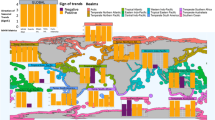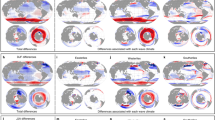Abstract
To predict future coastal hazards, it is important to quantify any links between climate drivers and spatial patterns of coastal change. However, most studies of future coastal vulnerability do not account for the dynamic components of coastal water levels during storms, notably wave-driven processes, storm surges and seasonal water level anomalies, although these components can add metres to water levels during extreme events. Here we synthesize multi-decadal, co-located data assimilated between 1979 and 2012 that describe wave climate, local water levels and coastal change for 48 beaches throughout the Pacific Ocean basin. We find that observed coastal erosion across the Pacific varies most closely with El Niño/Southern Oscillation, with a smaller influence from the Southern Annular Mode and the Pacific North American pattern. In the northern and southern Pacific Ocean, regional wave and water level anomalies are significantly correlated to a suite of climate indices, particularly during boreal winter; conditions in the northeast Pacific Ocean are often opposite to those in the western and southern Pacific. We conclude that, if projections for an increasing frequency of extreme El Niño and La Niña events over the twenty-first century are confirmed, then populated regions on opposite sides of the Pacific Ocean basin could be alternately exposed to extreme coastal erosion and flooding, independent of sea-level rise.
This is a preview of subscription content, access via your institution
Access options
Subscribe to this journal
Receive 12 print issues and online access
$259.00 per year
only $21.58 per issue
Buy this article
- Purchase on Springer Link
- Instant access to full article PDF
Prices may be subject to local taxes which are calculated during checkout





Similar content being viewed by others
References
Nicholls, R. J. et al. Sea-level rise and its possible impacts given a ‘beyond 4 °C world’ in the twenty-first century. Phil. Trans. R. Soc. A 369, 161–181 (2011).
Hallegate, S., Green, C., Nicholls, R. J. & Corfee-Morlot, J. Future flood losses in major coastal cities. Nature Clim. Change 3, 802–806 (2013).
Young, I. R., Zieger, S. & Babanin, A. V. Global trends in wind speed and wave height. Science 332, 451–455 (2011).
Mantua, N. J., Hare, S. R., Zhang, Y., Wallace, J. M. & Francis, R. C. A Pacific decadal climate oscillation with impacts on salmon. Bull. Am. Meteorol. Soc. 78, 1069–1079 (1997).
Wolter, K. The Southern Oscillation in surface circulation and climate over the tropical Atlantic, Eastern Pacific, and Indian Oceans as captured by cluster analysis. J. Clim. Appl. Meteorol. 26, 540–558 (1987).
Wolter, K. & Timlin, M. S. in Proc. 17th Clim. Diagnostics Work. 52–57 (CIMMS and the School of Meteorology, Univ. of Oklahoma, 1993).
Rogers, J. C. & van Loon, H. Spatial variability of sea level pressure and 500 mb height anomalies over the Southern Hemisphere. Mon. Weath. Rev. 110, 1375–1392 (1982).
Hemer, M. A., Church, J. A. & Hunter, J. R. Variability and trends in the directional wave climate of the Southern Hemisphere. Int. J. Climatol. 30, 475–491 (2010).
Wallace, J. M. & Gutzler, D. S. Teleconnections in the geopotential height field during the Northern Hemisphere. Mon. Weath. Rev. 109, 784–812 (1981).
Kuriyama, Y., Banno, M. & Suzuki, T. Linkages among interannual variations of shoreline, wave and climate at Hasaki, Japan. Geophys. Res. Lett. 39, L06604 (2012).
Storlazzi, C. D. & Griggs, G. B. Influence of El Niño-Southern Oscillation (ENSO) events on the evolution of central California’s shoreline. Geol. Soc. Am. Bull. 112, 236–249 (2000).
Sallenger, A. H. et al. Sea-cliff erosion as a function of beach changes and extreme wave runup during the 1997–1998 El Niño. Mar. Geol. 187, 279–297 (2002).
Allan, J. C. & Komar, P. D. Climate controls on US West Coast erosion processes. J. Coast. Res. 22, 511–529 (2006).
Abyswirigunawardena, D. S. & Walker, I. J. Sea level responses to climate variability and change in northern British Columbia. Atmosphere 46, 277–296 (2008).
Barnard, P. L. et al. The impact of the 2009–10 El Niño Modoki on U.S. West Coast beaches. Geophys. Res. Lett. 38, L13604 (2011).
Heathfield, D. K., Walker, I. J. & Atkinson, D. E. Erosive water level regime and climatic variability forcing of beach–dune systems on south-western Vancouver Island, British Columbia, Canada. Earth Surf. Land. 38, 751–762 (2013).
Smith, R. K. & Benson, A. P. Beach profile monitoring: How frequent is sufficient? J. Coast. Res. 34, 573–579 (2001).
Ranasinghe, R., McLoughlin, R., Short, A. & Symonds, G. The Southern Oscillation Index, wave climate, and beach rotation. Mar. Geol. 204, 273–287 (2004).
Harley, M. D., Turner, I. L., Short, A. D. & Ranasinghe, R. Interannual variability and controls of the Sydney wave climate. Int. J. Climatol. 30, 1322–1335 (2010).
Thom, B. G. in Landform Evolution in Australia: Canberra (eds Davies, J. L. & Williams, M. A.) 197–214 (Australian National University Press, 1978).
Bryant, E. Regional sea level, Southern Oscillation and beach change, New South Wales, Australia. Nature 305, 213–216 (1983).
Clarke, D. J. & Eliot, I. G. Low-frequency variation in the seasonal intensity of coastal weather systems and sediment movement on the beachface of a sandy beach. Mar. Geol. 79, 23–39 (1988).
Phinn, S. R. & Hastings, P. A. Southern Oscillation influences on the wave climate of south-eastern Australia. J. Coast. Res. 8, 579–592 (1992).
Dee, D. P. et al. The ERA-Interim reanalysis: Configuration and performance of the data assimilation system. Q. J. R. Meteorol. Soc. 137, 553–597 (2010).
Shimura, T., Mori, N. & Mase, H. Ocean waves and teleconnection patterns in the Northern Hemisphere. J. Clim. 26, 8654–8670 (2013).
Tokinaga, H. & Xie, S.-P. Wave- and anemometer-based sea surface wind (WASWind) for climate change analysis. J. Clim. 24, 267–285 (2011).
Mori, N., Yasuda, T., Mase, H., Tom, T. & Oku, Y. Projections of extreme wave climate change under global warming. Hydrol. Res. Lett. 4, 15–19 (2010).
Dobrynin, M., Murawsky, J. & Yang, S. Evolution of the global wind wave climate in CMIP5 experiments. Geophys. Res. Lett. 39, L18606 (2012).
Hemer, M. A., Fan, Y., Mori, N., Semedo, A. & Wang, X. L. Projected changes in wave climate from a multi-model ensemble. Nature Clim. Change 3, 471–476 (2013).
Semedo, A. et al. Projection of global wave climate change toward the end of the twenty-first century. J. Clim. 26, 8269–8288 (2013).
Previdi, M. & Liepert, B. G. Annular modes of Hadley cell expansion under global warming. Geophys. Res. Lett. 34, L22701 (2007).
Arblaster, J. M., Meehl, G. A. & Karoly, D. J. Future climate change in the Southern Hemisphere. Competing effects of ozone and greenhouse gases. Geophys. Res. Lett. 38, L02701 (2011).
Collins, M. et al. The impact of global warming on the tropical Pacific Ocean and El Niño. Nature Geosci. 3, 391–397 (2010).
Stevenson, S. L. Significant changes to ENSO strength and impacts in the twenty-first century: Results from CMIP5. Geophys. Res. Lett. 39, L17703 (2012).
Cai, W. et al. Increasing frequency of extreme El Niño events due to greenhouse warming. Nature Clim. Change 4, 111–116 (2014).
WCRP Coupled Model Intercomparison Project Phase 5—CMIP5. CLIVAR Exchanges 16 (Special issue), 1–52 (2011)
Cai, W. et al. Increased frequency of La Niña events under greenhouse warming. Nature Clim. Change 5, 132–137 (2015).
L’Heureux, M. L., Lee, S. & Lyon, B. Recent multidecadal strengthening of the Walker Circulation across the tropical Pacific. Nature Clim. Change 3, 571–576 (2013).
Erikson, L. H., Hegermiller, C. A., Barnard, P. L., Ruggiero, P. & van Ormondt, M. Projected wave conditions in the Eastern North Pacific under the influence of two CMIP5 climate scenarios. Ocean Model. (2015).
Harley, M. D., Barnard, P. L. & Turner, I. L. Coastal Sediments 2015: The Proceedings of the Coastal Sediments 2015 (World Scientific, 2015).
Acknowledgements
Funding for this project was provided by the Coastal and Marine Geology Program of the United States Geological Survey. California beach survey data collection was funded by the California Department of Boating and Waterways and the United States Army Corps of Engineers. Many thanks to C. Fletcher, A. Gibbs and B. Richmond for providing beach survey data from Hawaii. Waikato Regional Council and Hawkes Bay Regional Council provided the New Zealand data. Australian survey data collection in New South Wales was supported by the Australian Research Council and Warringah Council, with Queensland data provided by Gold Coast City Council. Wave and water level data for these sites was supplied by Manly Hydraulics Laboratory (New South Wales) and Gold Coast City Council (Queensland).
Author information
Authors and Affiliations
Contributions
P.L.B. and A.D.S. developed the original concept for this study. P.L.B. directed the analysis and wrote the original version of this paper. M.D.H., S.V. and E.R.-G., analysed the data. All authors contributed to interpreting results and improvement of this paper.
Corresponding author
Ethics declarations
Competing interests
The authors declare no competing financial interests.
Supplementary information
Supplementary Information
Supplementary Information (PDF 7477 kb)
Supplementary Information
Supplementary Information (XLSX 74 kb)
Supplementary Information
Supplementary Information (XLSX 22 kb)
Supplementary Information
Supplementary Information (XLSX 320 kb)
Supplementary Information
Supplementary Information (XLSX 92 kb)
Rights and permissions
About this article
Cite this article
Barnard, P., Short, A., Harley, M. et al. Coastal vulnerability across the Pacific dominated by El Niño/Southern Oscillation. Nature Geosci 8, 801–807 (2015). https://doi.org/10.1038/ngeo2539
Received:
Accepted:
Published:
Issue Date:
DOI: https://doi.org/10.1038/ngeo2539
This article is cited by
-
Seasonal forecasts of the world’s coastal waterline: what to expect from the coming El Niño?
npj Climate and Atmospheric Science (2024)
-
Earth science looks to outer space
Nature Geoscience (2023)
-
Benchmarking satellite-derived shoreline mapping algorithms
Communications Earth & Environment (2023)
-
Influence of El Niño on the variability of global shoreline position
Nature Communications (2023)
-
Pacific shoreline erosion and accretion patterns controlled by El Niño/Southern Oscillation
Nature Geoscience (2023)



